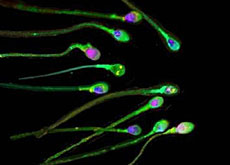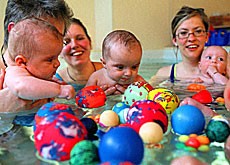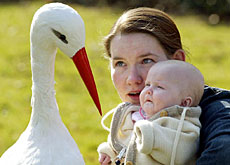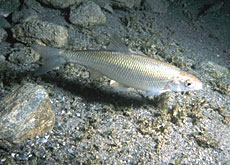Swiss sperm goes under the microscope

The first-ever nationwide study into the quality of Swiss sperm is due to get underway later this month amid concerns over declining male fertility.
Experts fear that chemicals present in the environment are acting as endocrine disruptors, altering the functioning of male hormones.
After Denmark, Switzerland has the highest rate of testicular and prostate cancer for young men aged 15-34 in Europe. Scientists have for some time suspected that pesticides, cosmetics and certain drugs are to blame for this and fertility problems.
A report released by the Swiss environment agency in 1999 concluded that such chemicals had already left their mark on the country’s landscape and implicated them as a general cause of population changes in wildlife.
“Infertility in men is one of the precursor symptoms of more serious diseases such as prostate and testicular cancer,” Professor Felix Althaus, head of the national research programme into endocrine disruptors, told swissinfo.
“Switzerland has one of the highest rates of these diseases, we want to find out why this is and what part endocrine disruptors play in this.”
The two-year study is being undertaken by researchers at Lausanne University Hospital who hope to collect sperm samples from around 3,000 army recruits.
Information sheets are to be sent out at the end of the month to 25,000 young men called up for military service, asking for volunteers.
Samples will be collected from the beginning of September and will be analysed for standard parameters such as concentration, sperm count, mobility and morphology.
Sperm count
Researchers hope to be able to establish whether there are regional variations in the quality of Swiss sperm – and if so what is responsible.
An American study published in the April 2003 issue of Environmental Health Perspectives found that men living in rural areas where there was extensive use of agricultural chemicals had considerably reduced semen quality than their urban counterparts.
Recruits will have to fill out a questionnaire on their medical history and lifestyle. Volunteers will also be asked to undergo a urological examination and provide blood and urine samples.
Retrospective analysis of 20,000 spermiograms conducted at the hospital over the past 30 years has already shown that the average sperm count is twice as high among Swiss men born in 1945 compared with those born in 1975.
“Exposure to estrogens or related compounds in the environment has been suspected of inducing detrimental effects on male reproductive development and of being responsible for a decline in spermatozoa concentrations in humans,” said Marc Germond, a professor of reproductive medicine, who is leading the study.
“Data will be collected to assess for the first time the geographical distribution of sperm qualities in Switzerland and to identify environmental effects based on regional differences.”
Geographical picture
The study will also look into the origin of the father and the geographical location of the mother during pregnancy. The study’s findings are expected to be ready by the middle of 2007.
“There is an urgent need for the development of simple gauges and tools to check the parameters known to affect male fertility,” stressed Germond.
The professor added that preventive measures could be implemented if sperm quality was found to be worse in certain areas.
The study is one of 27 projects assessing the effects and the risks of endocrine disruptors on humans, domestic animals, wildlife and environment in Switzerland. The national research programme, which runs until 2007, has received SFr15 million ($11.6 million) from the government.
Another of the studies hopes to establish whether endocrine disruptors are responsible for genital malformations in whitefish in Lake Thun.
swissinfo, Adam Beaumont in Geneva
3,000 army recruits are to take part in the study.
Researchers are due to start collecting sperm samples in September.
The findings should be available by the middle of 2007.
Various solvents, insecticides, pesticides, combustion products, certain drugs, cosmetics and even plant products are suspected to be endocrine active.
In humans, disturbances of foetal development, a decrease in fertility and the increased incidence of breast, testicular and prostate cancer have been reported.
In animals, numerous studies attest to reproductive disturbances across a broad species spectrum ranging from fishes to marine and terrestrial mammals. The disappearance of otters in Switzerland is attributed to this.

In compliance with the JTI standards
More: SWI swissinfo.ch certified by the Journalism Trust Initiative



You can find an overview of ongoing debates with our journalists here . Please join us!
If you want to start a conversation about a topic raised in this article or want to report factual errors, email us at english@swissinfo.ch.